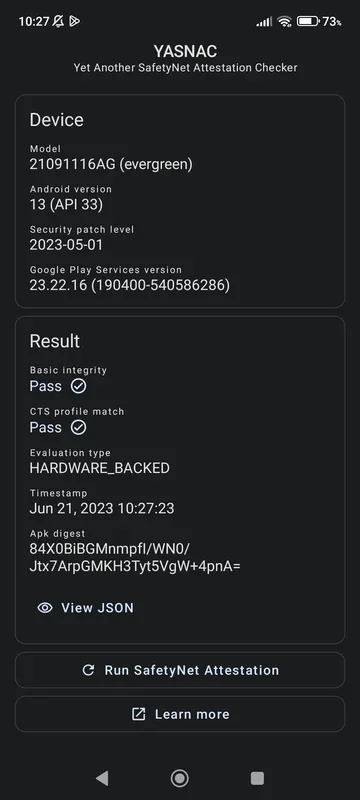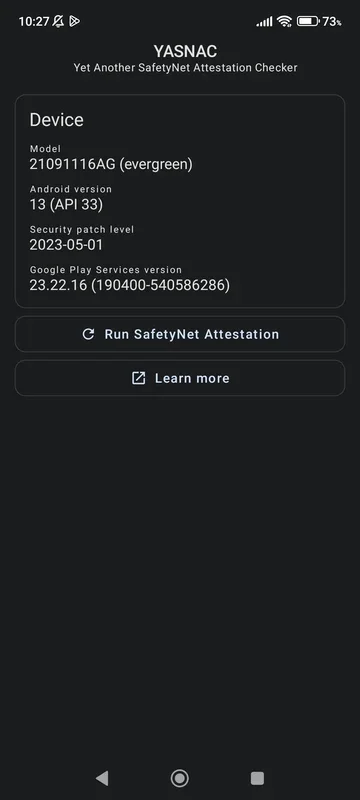YASNAC - SafetyNet Checker App Introduction
Introduction to YASNAC - SafetyNet Checker
YASNAC - SafetyNet Checker is a remarkable tool in the Android ecosystem. It serves a very specific yet important purpose for Android users, especially those with rooted devices. Rooting an Android device can bring a lot of advantages such as customizing the device to one's liking, getting access to certain apps that are not available on the official app store, and enhancing the overall performance. However, it also comes with some drawbacks. One of the major issues is that many apps, especially those related to financial transactions like banking apps, use Google SafetyNet to determine if a device is secure enough to run their services. A rooted device may not pass this SafetyNet check, which can limit the usability of certain apps.
YASNAC - SafetyNet Checker steps in to fill this gap. It allows users to quickly and easily check whether their rooted Android device can pass the Google SafetyNet test. This is crucial as it gives users an idea of whether they can use certain apps on their device or if they need to take further steps to ensure compatibility.
How YASNAC - SafetyNet Checker Works
The working of YASNAC - SafetyNet Checker is based on the underlying mechanisms of Google SafetyNet. Google SafetyNet is a verification system that is integrated with Google Play Services. It uses multiple techniques to assess the integrity of an Android device. For example, it checks if the device has been rooted, if the bootloader is unlocked, and if there are any unauthorized modifications to the system.
When a user launches YASNAC - SafetyNet Checker on their Android device, the app first gathers some basic information about the device. This includes details such as the device model, the Android version that is currently installed, the security patch level, and the version of Google Play Services. This information is important as it can give some insights into why a device may or may not pass the SafetyNet test.
After gathering this information, the user can then initiate the SafetyNet test by clicking on the appropriate button within the app. The test checks for different aspects of the SafetyNet criteria. It checks if the device passes the basic integrity test, which verifies if the device has not been tampered with in a way that could compromise security. It also checks the CTS (Compatibility Test Suite) profile, which ensures that the device meets the compatibility standards set by Google. Additionally, it determines the type of evaluation, whether it is a hardware - based evaluation or a basic one.
The Importance of Google SafetyNet for Android Devices
Google SafetyNet plays a vital role in the Android ecosystem. It is designed to protect both the users and the app developers. For users, it ensures that their devices are secure and that they are not using apps on a potentially compromised device. For example, if a device has been rooted in an unauthorized way, it could be vulnerable to malware attacks. By using SafetyNet, apps can avoid running on such devices, thus protecting the user's data and privacy.
For app developers, SafetyNet provides a standard way to ensure that their apps are running on a secure and compliant device. This is especially important for apps that deal with sensitive information such as banking apps, payment apps, and apps that store personal information. If an app runs on a device that has been compromised, it could lead to data breaches and other security issues. By relying on SafetyNet, app developers can have more confidence in the security of the devices on which their apps are running.
YASNAC - SafetyNet Checker vs. Other Similar Tools
There are other tools in the market that claim to perform similar functions as YASNAC - SafetyNet Checker. However, YASNAC - SafetyNet Checker has several advantages. One of the main advantages is its simplicity. The user interface of YASNAC - SafetyNet Checker is very straightforward and easy to use. Even a novice Android user can quickly understand how to use the app to check the SafetyNet status of their device.
Another advantage is the accuracy of the results. YASNAC - SafetyNet Checker provides detailed and accurate information about the device's SafetyNet status. It not only tells the user whether the device has passed or failed the test but also provides additional information such as the type of evaluation and the CTS profile. This can be very useful for users who want to further troubleshoot any issues related to SafetyNet.
In comparison, some other tools may not provide such detailed information or may have a more complex user interface, making it difficult for users to understand and use the tool effectively.
Tips for Using YASNAC - SafetyNet Checker
When using YASNAC - SafetyNet Checker, there are a few tips that can enhance the user experience. First, make sure that your device has a stable internet connection. Since the app uses Google Play Services to perform the SafetyNet test, a stable internet connection is required to ensure accurate results.
Secondly, keep your device's software up - to - date. This includes both the Android version and the Google Play Services version. Out - of - date software can sometimes cause issues with the SafetyNet test, and by keeping your software up - to - date, you can increase the chances of getting accurate results.
Finally, if your device fails the SafetyNet test, don't panic. There are ways to potentially fix the issue. For example, you can try to unroot your device if possible, or you can look for other solutions such as using a different method to bypass the SafetyNet detection (although this may not be legal or recommended in all cases).
Conclusion
YASNAC - SafetyNet Checker is an invaluable tool for Android users, especially those with rooted devices. It provides a simple and effective way to check the Google SafetyNet status of a device. By understanding the importance of Google SafetyNet, how YASNAC - SafetyNet Checker works, and how it compares to other similar tools, users can make more informed decisions about the security and usability of their Android devices.

